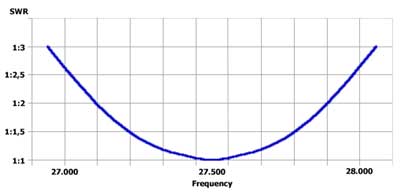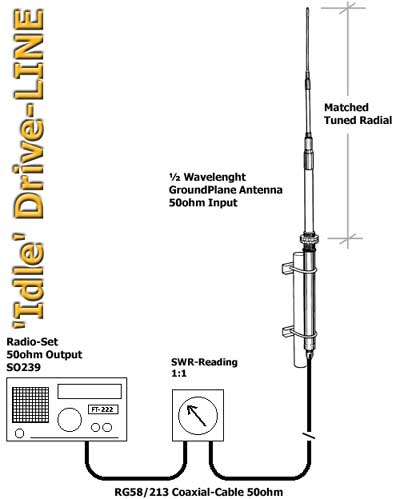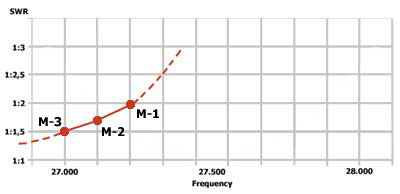
Interference HOW-TO
Page 1 - Page 2 - Page 3 - Page 4 - Page 5 - Page 6
Antenna tuning
This page Covers How-To tune your antennas,- to get them to work on the decided frequencies with acceptable SWR.
SWR What?
You have probably heard about it but whath is it al about. 'Standing Wave Ratio' or in short 'SWR' is the value used to messure, or state the 'ratio' between the forward (output) power and the reflected (non-radiated) power
SWR is a result of impedance mismatch in the antenna or feed-line.

Sample 'IDLE' - SWR-Curve
The 'SWR-Curve' above shows the SWR per frequency for a 'Normal' Transceiver antenna. The center frequency is 27.500 with perfect match (SWR=1:1) From the curve you can also read that the 'Band-width' of the antenna is about 800KHz with SWR going up to 1:2,- You should NOT use any antenna above this SWR-Level, this will only jepardize your equipment.
The perfect antenna and feed-line
Here i describe an 'idle' setup using unbalanced groundwave (GP) vertical antenna (A99 5/8 wavelenght o.e.) i also assume that your connectors and cables is in good condition.
1. Starting from your radio,- the antenna output is often a SO239 connector with the impedance of 50ohm, and is ALWAYS unbalanced (For use with Coaxial-cable)
2. Your Feed-Line consists of an RG-58 Coaxial-cable,- the impedance of the cable is 50ohm,- it is also unbalanced.
3. Your antenna is a normal Ground-plane antenna,- with 1/2 wave-lenght radial, you connect the coaxial-cable to an SO239 connector at the antenna bottom - The antenna is also unbalanced. This setup is 'idle'

The perfect antenna and feed-line
If you got problems with SWR in this type of station-setup it is always a cause of mismatch in the antenna lenght, because the Radio-Feedline-antenna characteristics and impedance is the same. In these samples we assume that your connectors and cables is in good condition.
The Cure!
The way to solve this type of problem is by adjusting your antenna center frequency. You must first determine if your antenna is to short or to long? The following procedure is a simple way. Refere also to the 'IDLE' SWR-Curve above and the SWR-Diagram for the sample SWR-Values below.
To do this you need to be able to Measure your SWR-Value with separate SWR-Meter or if your radio have a built in SWR-Meter. It is prefered to Measure your SWR at the antenna,- however it is more practical to do so at your radio as in the sample.
- Go on a frequency where your able to transmit with less than 1:3 in SWR.
- Transmit on AM or FM modulation. Measure your SWR-Value. (Value M-1)
- Change frequency with about 100Khz. (Down) Measure your SWR-Value. (Value M-2) - Change frequency again with about 100Khz. (Down)(M-3) If the SWR goes down you can continue until you reach the frequency for SWR=1:1 - If SWR Goes up,- you must change frequency in opposite direction.

Sample SWR-Values
- Measure your SWR - SAMPLE -
@27.200MHz your SWR-Meter reading is 1:2 (M-1) at 100KHz lower frequenzy the SWR drops to about 1:1,7 (M-2) - And @27.000MHz it drops ewen more 1:1,5 (M-3) The prolonged lined (dotted) illustrates the actual SWR-Curve for the sample-antenna,- You probably finde the center frequency 100-200KHz below 27.000MHz.
Conclusion
In the sample, the center frequency for the antenna is about 26.800MHz - If your prefered center frequency is higher you need to shorten the antenna and vise-versa.
Calculation - ((300/[actual c-freq])-(300/[prefered c-freq]))/2 = ((300/26,8)-(300/27,5))/2 = 14,2cm
Modern antennas s.a. the A99 however uses 'matching' rings at the antenna-foot - Refere to the antenna manual for adjustning center-frequency on such antennas.
Matching Feed-Lines
This is most important to the performance of your Transceiver stations.
If you detect SWR at your radio-set,- firts check cables and connections - Then proceed by determine center frequency for your antenna,- if not
Page 1 - Page 2 - Page 3 - Page 4 - Page 5 - Page 6
*** End of page ***
<--Back
